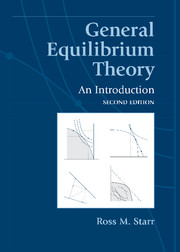Book contents
- Frontmatter
- Contents
- List of illustrations
- Introduction to the second edition
- Preface to the second edition
- Preface to the first edition
- Table of notation
- Table of assumptions
- A General equilibrium theory: Getting acquainted
- B Mathematics
- C An economy with bounded production technology and supply and demand functions
- D An economy with unbounded production technology and supply and demand functions
- E Welfare economics and the scope of markets
- F Bargaining and equilibrium: The core
- G An economy with supply and demand correspondences
- H Standing on the shoulders of giants
- Bibliography
- Index
E - Welfare economics and the scope of markets
Published online by Cambridge University Press: 05 June 2012
- Frontmatter
- Contents
- List of illustrations
- Introduction to the second edition
- Preface to the second edition
- Preface to the first edition
- Table of notation
- Table of assumptions
- A General equilibrium theory: Getting acquainted
- B Mathematics
- C An economy with bounded production technology and supply and demand functions
- D An economy with unbounded production technology and supply and demand functions
- E Welfare economics and the scope of markets
- F Bargaining and equilibrium: The core
- G An economy with supply and demand correspondences
- H Standing on the shoulders of giants
- Bibliography
- Index
Summary
Ever since Adam Smith's evocation of an invisible hand, market equilibrium has been supposed not only to clear markets but also to achieve an efficient allocation of resources. This view is embodied in Chapter 19 in a definition and two major results. We define a very general efficiency concept, Pareto efficiency. We then state and prove the two major results relating market equilibrium to efficient allocation, which are the two most important results in welfare economics.
The First Fundamental Theorem of Welfare Economics agrees with Adam Smith: A market equilibrium allocation is Pareto efficient. This result can be demonstrated in a surprisingly elementary fashion. It requires very little mathematical structure, and it does not require any assumption of convexity. If, despite nonconvexity, the economy has a market equilibrium, that equilibrium allocation is Pareto efficient.
The Second Fundamental Theorem of Welfare Economics requires more mathematical structure. It is a more surprising and deeper result. It says – assuming convexity of tastes and technology – that any efficient allocation can be supported as a competitive equilibrium. Find an efficient allocation. Then there are prices and a distribution of resource endowments of goods and share ownership that will allow the efficient allocation to be an equilibrium allocation at those prices and endowments. Market allocation is compatible with any efficient allocation subject to a redistribution of income.
The models treated here can be interpreted to treat allocation over time and under uncertainty. To do so, the space of commodities traded needs to be interpreted to include intertemporal trade and trade in insurance or event-contingent goods.
- Type
- Chapter
- Information
- General Equilibrium TheoryAn Introduction, pp. 203 - 204Publisher: Cambridge University PressPrint publication year: 2011



